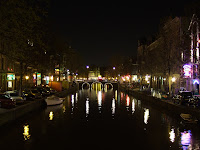
Amsterdam is a city of many different faces. (Many of them on angry cyclists that kept silently sneaking up on us from the 'wrong' side on cycle lanes that we kept mistaking for footpaths!)

We started our first day with a walk that ended at Anne Frank’s house. Despite the fact that we were there before 10 a.m. the queue was around 50-60m long. So, instead, we bought a hop-on-hop off canal boat ticket: excellent value; a great way to have an introduction to the City as they provide a commentary on their 3 routes exploring the canals.

After a 90-minute trip around the outermost of the three concentric canals we walked to Dam Square, and then wandered around the old Jewish quarter.
Sitting at a street café looking across to the Waag we enjoyed a delicious salad lunch, and then wandered off to visit the museum in the house Rembrandt owned and worked in for 20 years. Sadly, he went bankrupt, but from the detailed inventories made at the time of the forced sale the museum has been able to restore and furnish the house as it was when Rembrandt lived and worked there.

We saw his living areas, as well as the reception entry where he received potential clients, from all over the world, as an art dealer selling his works as well as those of other Masters. We also saw his studio, the area where his students worked and the room where he kept his extensive collection of items from the natural world or antiquity that he used as inspiration. In the modern wing alongside the house was an extensive collection of Rembrandt’s sketches and etchings.

In the Rembrandt theme, after a ride on another canal loop, we visited the restricted display at the Rijksmuseum. It is undergoing an extensive re-development and the cream of the exhibits is displayed in a temporary area. They have a good collection of Rembrandt's paintings, including ‘The Night Watch’ and some of the ‘famous’ Vermeer’s.
Since it was now well after 7 p.m. we thought that the Anne Frank queue might have shortened so detoured in that direction. The queue was at least twice as long as in the morning: looks like an early morning start is the answer.

With nothing else to achieve in the day we meandered our way back our hotel via the Red Light district. This is a very different face of Amsterdam. The available girls are sitting/standing in windows or behind glass doors, even in the daytime. Under the red neon lights are rows of curtained glass doors where it all takes place, just an easy step inside the door from the footpath.

The guide books warn of the consequences of taking photos, so you just have to imagine a beauty pageant with all the contestants in their bikinis, but instead of standing in a row on a stage, they are all behind glass doors in every house along particular streets, often looking totally bored. Perhaps one needed to show a bit of interest in what they were offering to solicit some sort reciprocal response.
The footpaths were crowed with groups of curious tourists. (Clearly this did not include us – we were simply returning to our hotel!)


 By the time our final canal cruise had finished, the day had improved considerably so we bought a Bus Pass to the Waterland area. What excellent value! For €10, the two of us (but we could have had 5 people), we were able to travel all day this area. We intended to bus all the way to Marken but the first bus that came along was going via Monnickendam, the first stop on our intended route, so we took it and explored this very picturesque market town.
By the time our final canal cruise had finished, the day had improved considerably so we bought a Bus Pass to the Waterland area. What excellent value! For €10, the two of us (but we could have had 5 people), we were able to travel all day this area. We intended to bus all the way to Marken but the first bus that came along was going via Monnickendam, the first stop on our intended route, so we took it and explored this very picturesque market town.
 Back on the bus again we crossed the causeway to Marken, until the 50’s an island with a population of 70 families. This small fishing village now has a population of 2000 but the original town has, apparently, no street names – with only 70 families why would you need them?
Back on the bus again we crossed the causeway to Marken, until the 50’s an island with a population of 70 families. This small fishing village now has a population of 2000 but the original town has, apparently, no street names – with only 70 families why would you need them?









































